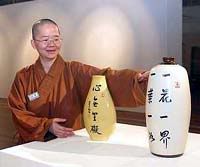Chư Tăng Tích Lan cực lực phản đối cứu trợ cho quân phiến loạn bạo động Tamil trong thảm họa sóng thần Tsunami.
Tin từ Colombo, Tích Lan , thứ ba, tháng tư ngày 26, một đảng chính trị cầm đầu bởi nhiều nhà sư có thế lực mạnh của Tích Lan cực lực lên án và phản đối chính phủ Tích Lan đã sử dụng những nguồn viện trợ cho nước này từ ngoại quốc trong tai họa sóng thần Tsunami vừa qua để viện trợ phần nào cho bọn phiến loạn cực đoan Tamil (còn gọi là đảng con cọp ).
Các tu sĩ Phật Giáo Tích Lan thuộc đảng bảo thủ dân tộc tại Tích Lan khẳng định rằng bọn phiến loạn Tamil đã và đang dùng tiền cứu trợ để phá hoại Phật Giáo Tích Lan và các quốc gia đạo Phật khác theo lời phóng viên Athuralive Ratana Thero của tờ báo “Island”.
Sự phản đối này có thể dẫn tới chính phủ Tích Lan phải cắt bớt Viện trợ Tsunami của đảng phiến loạn cực đoan Tamil, hiện đang kiểm soát những phần đất thuộc phía Đông Bắc của Tích Lan, nơi thảm họa sóng thần Tsunami vừa qua đã làm thiệt mạng khoảng 31,000 người tại đất nước này.
Bọn phiến loạn Talmil đã nhiều lần đòi hỏi một phần viện trợ nước ngoài trong thảm hoạ sóng thần tại Tích Lan từ phía chính phủ. Tuy nhiên những tổ chức cứu trợ và từ thiện quốc tế rất dè dặt trong sự cung cấp viện trợ cho bọn phiến loạn Hồi Giáo Cực đoan Tamil, đặc biệt trong những vùng đất hiện nay chúng cai quản, vốn đã được đưa lên danh sách đen của bọn khủng bố quốc tế tại Ấn Độ và Hoa Kỳ.
Đầu tháng tư vừa qua, Đảng Mác Xít tự do cấp tiến đe doạ họ sẽ tách rời khỏi chính phủ Tích Lan, nếu chính phủ vẫn còn hợp tác và viện trợ cho những vùng bọn phiến loạn đang kiểm sóat trong nạn hồng thủy Tsunami vừa qua.
DươngTiêu Dịch.
http://www.hindustantimes.com/news/7598_1337064,000500020002.htm
Sri Lankan Buddhist party opposes tsunami aid to Tamil rebels
Press Trust of IndiaColombo, April 26, 2005 12:13 IST
A political party led by several of Sri Lanka's powerful Buddhist monks has opposed a government move to give partial control of foreign tsunami aid to the Tamil Tiger rebels, a news report said on Tuesday.
The party said it against the move because the rebels have continued to target those opposed to them and cannot be trusted with the funds, Athuraliye Ratana Thero, a spokesman for the National Heritage Party, was quoted as saying by the 'Island' newspaper.
The party's opposition could complicate government efforts to share tsunami aid with the Liberation Tigers of Tamil Eelam, which controls areas of the island's north-east that were hit by the December 26 tsunami, which killed at least 31,000 in Sri Lanka.
The rebels have repeatedly demanded access to a portion of the foreign aid that has poured into Sri Lanka. But most international donors are reluctant to give funds directly to the rebel group, which is listed as a terrorist organisation in the United States and India.
Earlier this month, the Marxist People's Liberation Front, threatened to quit the governing coalition if a joint body was formed with the rebels.
http://www.hindustantimes.com/news/7598_1337064,000500020002.htm
 Ru with some of the unique pottery with venerable monk Hsing Yun's calligraphy.
Ru with some of the unique pottery with venerable monk Hsing Yun's calligraphy. Guwahati, India_ Như các chuyên gia và học giả đã nhận xét, Phật giáo tại miền Ðông Bắc Ấn với những ảnh hưởng ngoại lai đã nhanh chóng đánh mất bản sắc, đe dọa đến niềm tin sâu đậm từ hằng nghìn năm qua. Thêm một kết luận được đưa ra trong cuộc hôị thảo mới đây tại Guwahati của các nhà nghiên cứu và giới tu sĩ.
Guwahati, India_ Như các chuyên gia và học giả đã nhận xét, Phật giáo tại miền Ðông Bắc Ấn với những ảnh hưởng ngoại lai đã nhanh chóng đánh mất bản sắc, đe dọa đến niềm tin sâu đậm từ hằng nghìn năm qua. Thêm một kết luận được đưa ra trong cuộc hôị thảo mới đây tại Guwahati của các nhà nghiên cứu và giới tu sĩ.